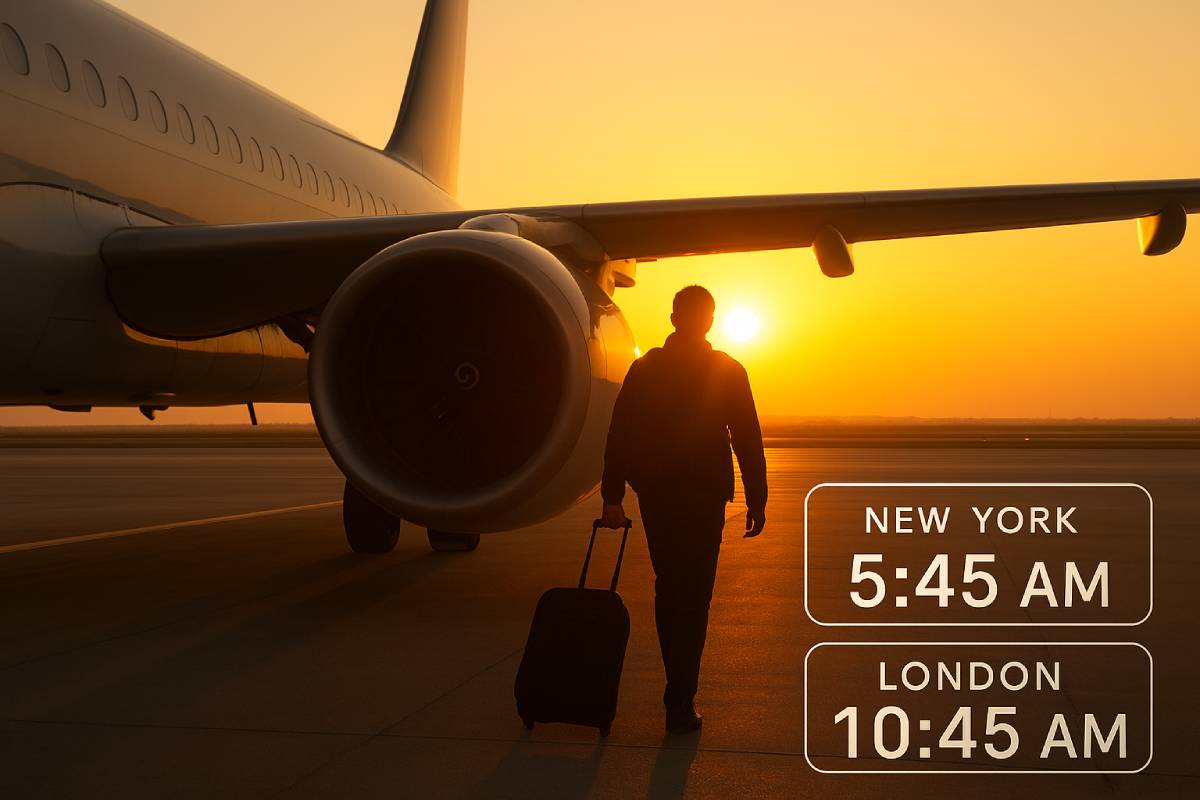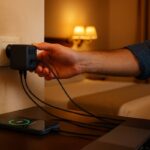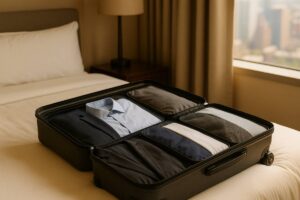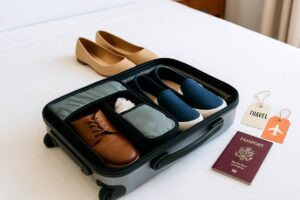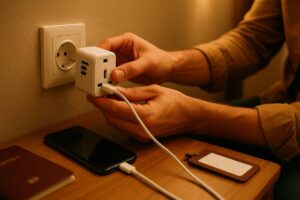If you’ve ever landed in Tokyo after an LA morning and felt like a zombie, you’re not alone: jet lag disrupts your brain’s master clock—the suprachiasmatic nucleus—leaving you dozy, irritable, and even queasy for days.
But you don’t have to suffer: science shows that strategic light exposure (morning sun for eastward hops, evening glow for westward) and meal-timing cues can shave 20–40% off your recovery time.
Add low-dose melatonin, in-flight nap alignment, and brisk movement breaks, and you’ll re-entrain in as little as one day per zone crossed—sometimes even faster. Ready to reclaim your rhythm?
Understanding Jet Lag
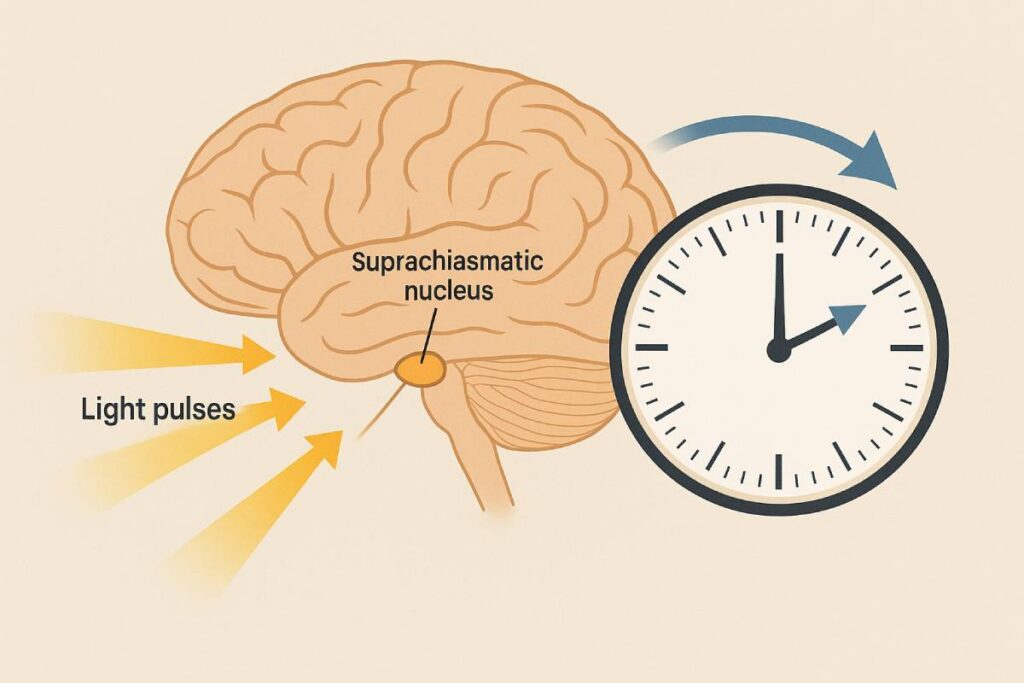
Jet lag is a temporary misalignment between your internal body clock and the local time at your destination, driven by rapid travel across time zones. At its core, the suprachiasmatic nucleus (SCN) in your brain uses light cues to regulate sleep, hormone release, metabolism, and digestion; when these rhythms remain tied to your departure zone, you experience chronodisruption.
Typical symptoms—difficulty falling or staying asleep, daytime fatigue, and gastrointestinal upsets such as constipation or diarrhea—usually manifest within 24–48 hours of crossing two or more time zones. Recovery takes roughly 1–1.5 days per time zone crossed, meaning a six-zone eastward journey could require up to nine days to fully adapt.
Eastward travel tends to be more challenging than westward travel because human circadian cycles average slightly longer than 24 hours, making phase advances harder than delays.
What Is Jet Lag?
Definition and physiology of circadian disruption
Jet lag is a temporary physiological condition that occurs when a person’s internal circadian rhythm is out of sync with local time after rapid travel across two or more time zones. The body’s master clock, located in the suprachiasmatic nucleus (SCN) of the hypothalamus, orchestrates daily cycles of sleep, hormone release, core temperature, and metabolism by processing light input from the retina.
When you fly across time zones, the SCN remains entrained to the original light–dark schedule, causing a misalignment between endogenous rhythms and external cues—a state known as circadian disruption.
Common symptoms: sleep disturbances, fatigue, GI issues
- Sleep disturbances: Difficulty falling asleep at local bedtime, early awakenings, or non-restorative sleep are hallmark signs.
- Daytime fatigue: Excessive sleepiness, mental fog, and reduced alertness can impair performance and mood.
- Gastrointestinal issues: Desynchronized digestive hormone rhythms often lead to constipation, diarrhea, indigestion, or appetite changes.
- Onset window: Symptoms typically emerge within 24–48 hours of travel and can last several days, depending on distance and direction.
Why Direction Matters
Eastward vs. westward travel and natural circadian bias
Most travelers find eastward journeys (losing hours) harder than westward journeys (gaining hours). This asymmetry arises because the intrinsic free-running period of the human circadian clock averages about 24.2 hours, slightly longer than the solar day, making phase delays (shifting later) easier than phase advances (shifting earlier).
Sleep Foundation data show that 75% of people report more severe symptoms after eastward travel, while only 25% find westward travel more challenging.
Expected adjustment difficulty by direction
Recovery rate varies by direction:
| Time Zones Crossed | Days to Adjust (Eastward) | Days to Adjust (Westward) |
|---|---|---|
| 1 | 1.5 | 1 |
| 3 | 4.5 | 3 |
| 6 | 9 | 6 |
| 8 | 12 | 8 |
Based on an average adaptation rate of 1–1.5 days per time zone crossed.
Pre-Travel Preparation
Jet-lag resilience starts before you board: gradually shifting sleep times by 30–60 minutes per day beginning three days before departure primes your circadian clock for the new time zone. Leveraging personalized planning tools like Timeshifter—which tailors light, sleep, and nap schedules to your chronotype—can reduce the likelihood of very severe jet lag by over 14-fold.
At-home simulated light protocols, combining bright white light in the morning and blue-depleted light in the evening, have been shown to effectively phase-shift circadian rhythms in as little as three days. Aligning meal timing—favoring larger breakfasts and lighter dinners—entrains peripheral metabolic clocks, supporting overall rhythm synchronization. Finally, proactive hydration and avoiding alcohol or caffeine during key windows preserves sleep quality and mitigate fatigue.
Sleep Schedule Shifting Timeline
Gradually shifting your sleep schedule three days before travel by 30–60 minutes each day helps align your body clock with destination time. In the final 1–2 days before departure, fine-tune your bedtime and wake-up time by 15–30 minutes to closely match local sleep–wake cycles, further reducing misalignment on arrival.
| Days Before Departure | Action |
|---|---|
| 3 days | Shift bedtime and wake-up time by 30–60 minutes toward destination schedule |
| 1–2 days | Fine-tune by 15–30 minutes to match local sleep–wake times |
Personalized Planning Tools
- Timeshifter (Jet Lag App): Delivers chronotype-based light, sleep, and nap schedules to travelers; users following its advice are 14.1 times less likely to report very severe jet lag.
- Sleep Foundation Recommendations: Advocates integrating digital planning tools for precision adjustment of pre-trip sleep and light cues to optimize adaptation.
Simulated Light Exposure
- Bright Morning Light: Self-administer two hours of high-intensity (> 5,000 lux) white light in the early morning to phase-advance circadian rhythms for eastward travel; similar schedules apply for phase delays.
- Blue-Depleted Evening Light: Expose yourself to dimmer, blue-filtered light (e.g., 30 minutes before bedtime) to reinforce intended sleep phases and avoid delays.
- Avoidance Strategies: Use blue-blocking glasses or dark goggles during times when light exposure would counteract your desired phase shift; tinted eyewear filters sleep-disrupting wavelengths effectively.
Meal Timing Adjustment
- Large-Meal/Light-Meal Pattern: Consume a substantial, protein-rich breakfast and lunch, then taper to lighter meals in the evening; this metabolic entrainment signals peripheral clocks to shift in tandem with your planned sleep–wake cycle.
- Phase-Shifted Mealtimes: Research shows that delaying or advancing meals by up to five hours can shift hormonal rhythms, reinforcing circadian adaptation.
Hydration & Substance Considerations
- Water Intake Protocols: Drink water before, during, and after your flight to counteract cabin dehydration and reduce fatigue; aim for at least 250 ml per hour in flight and refill your reusable bottle at airport stations.
- Avoid Alcohol & Caffeine: Refrain from both within 4–6 hours of your target sleep window; alcohol fragments sleep architecture, and caffeine’s half-life can disrupt falling asleep, exacerbating jet-lag symptoms.
In-Flight Strategies
In-flight strategies are your on-the-go toolkit for fast-tracking circadian alignment, preserving alertness, and arriving refreshed. Timing naps to match your destination’s nighttime window can significantly accelerate your body clock adjustment. Controlling cabin light and dark with a high-quality sleep mask, ambient seat lighting, and minimized screen use supports melatonin production and deep sleep in flight.
Regular movement—through seated stretches and aisle walks—boosts circulation, reduces stiffness, and lowers clot risk on long hauls. Finally, combating low-humidity cabin air by sipping at least 250 ml of water per hour and avoiding diuretics like alcohol and caffeine within your pre-sleep window helps maintain hydration and sleep quality.
Sleep Alignment on the Plane
- Strategic Nap Timing: Planning in-flight naps to align with the nighttime hours at your destination can accelerate circadian adaptation. Sleeping when it’s night at your endpoint helps your body release melatonin in sync with local time.
- Reset Your Watch and Mind: Rick Steves recommends using your seat-back entertainment downtime for focused naps and resetting all clocks to local time once aboard, preventing mental reminders of home time and preserving alertness upon landing.
Light & Dark Environment Management
- Eye Masks & Noise Control: Blocking stray cabin light with a premium eye mask enhances melatonin production and deep sleep, while pairing it with earplugs or noise-cancelling headphones cuts auditory distractions.
- Ambient Lighting Cues: Airlines like Qantas employ blue-enriched lighting scenes on ultra-long-haul flights to cue circadian shifts; research shows color-specific lighting can support faster adaptation by simulating dawn or dusk effects in the cabin.
- Screen-Time Discipline: Activating airplane mode and minimizing exposure to device screens during planned sleep periods prevents blue-light interference with sleep onset mechanisms.
Movement & Exercise
- Seated Calf-Pump Exercises: Perform foot pumps and ankle circles for 2–3 minutes every hour to activate the calf-muscle pump, reducing blood pooling and DVT risk.
- Aisle Walks: Booking an aisle seat and walking the cabin at least once per hour breaks up long periods of immobility, invigorates circulation, and helps maintain daytime alertness.
- Lavatory Stretches: Incorporate simple hamstring extensions, torso twists, and calf raises while waiting in line for the lavatory to relieve stiffness and promote blood flow.
Hydration Maintenance
Low cabin humidity (< 20 %) can accelerate dehydration, exacerbating fatigue and dulling cognition. Follow these guidelines to stay optimally hydrated and support in-flight sleep quality:
| Hydration Metric | Recommendation |
|---|---|
| Cabin Humidity | Often < 20 %—be proactive in drinking water |
| Water Intake | ≥ 250 ml per hour in flight |
| Diuretics to Avoid | No alcohol or caffeine within 4–6 h of intended sleep |
- Pre-Boarding Prep: Fill a reusable water bottle after security to ensure easy access throughout the flight—many airports now offer hydration stations at gates.
- Mindful Consumption: Sip regularly rather than gulping to maintain steady hydration; avoid spaces that restrict movement (e.g., under-seat baggage) so you can hydrate and stretch comfortably.
Post-Arrival Adjustment
Post-arrival, timed light exposure is the cornerstone of circadian realignment: seek morning sunlight after eastward travel and evening light after westward travel to reset your internal clock. When natural light isn’t accessible, portable light therapy devices such as Re-Timer glasses or Lumie lamps can simulate dawn or dusk cues to accelerate adjustment.
Supplementing with 1–3 mg of fast-release melatonin near your target bedtime further advances or delays rhythms in harmony with light interventions, though you should consult a healthcare provider before beginning any regimen.
Aligning breakfast, lunch, and dinner to local meal times entrains peripheral metabolic clocks, reducing the duration of jet lag symptoms. Finally, timed exercise—morning workouts after eastward flights and afternoon sessions after westward trips—reinforces your new sleep–wake cycle for faster adaptation.
Light Exposure Timing
Eastward: Morning Light
After an eastward flight, aim for at least 30–60 minutes of natural or simulated bright light within two hours of local sunrise to advance your circadian phase and promote earlier sleep onset. This strategy leverages the phase‐advance portion of the light phase‐response curve, helping your internal clock align with the destination’s day–night cycle.
Westward: Evening Light
When traveling westward, exposure to bright light during the early evening (e.g., 5–7 pm local time) delays your circadian phase, allowing you to stay awake later and adjust more smoothly to a later bedtime. Avoiding bright morning light on arrival further reinforces this delay and prevents premature phase advancement.
Use of Light Therapy Devices
| Device | Recommended Use | Key Feature |
|---|---|---|
| Re-Timer Glasses | 50 minutes/session, morning or evening based on direction | Portable, emits therapeutic green light |
| Lumie Vitamin L Lamp | 20–30 minutes of bright white light daily | Travel-friendly, high-lux output |
| HumanCharger Headset | 12-minute sessions for rapid circadian cues | Light via ear canals, ultra-portable |
When natural sunlight is limited (e.g., winter or indoor layovers), these devices replicate key wavelengths that influence the suprachiasmatic nucleus, ensuring consistent zeitgeber signals for phase shifting.
Melatonin Supplementation
Guidelines: 1–3 mg Fast-Release Near Bedtime
Fast-release melatonin at doses of 1–3 mg taken 30–60 minutes before your intended local bedtime can effectively advance or delay your circadian rhythm depending on travel direction. Studies show this dosage optimally reduces sleep onset latency without excessive residual effects the next morning.
Medical Disclaimer and Consultation Advice
Always consult with a healthcare professional before initiating melatonin, especially if you have underlying health conditions or are taking other medications. Melatonin is generally well-tolerated, but potential interactions and contraindications (e.g., autoimmune disorders, anticoagulant therapy) warrant personalized medical guidance.
Local Meal Timing
Aligning meals to local breakfast, lunch, and dinner times reinforces peripheral clock entrainment alongside light cues. Aim to consume your largest meal at local lunchtime to signal daytime activity, tapering to a lighter dinner within 2–3 hours of your target bedtime to avoid digestive disruption. Consistent meal timing helps synchronize metabolic hormones like insulin and ghrelin with the new time zone, smoothing the transition.
Exercise & Daytime Activity
Morning vs. Afternoon Workouts: After eastward travel, schedule moderate-intensity exercise (e.g., jogging or brisk walking) in the morning to promote alertness and reinforce the advanced phase of your circadian rhythm. Conversely, westward travelers benefit from afternoon workouts, which provide a mild phase delay cue and help regulate sleep–wake timing. Regular daytime activity also combats fatigue, enhances mood, and supports healthy sleep onset at night.
Timeline for Full Adaptation
Jet lag recovery varies by direction, individual traits, and traveler profile. As a rule of thumb, most people need about one day per time zone crossed when flying east—and around half a day per zone when flying west—to fully realign their circadian rhythms. However, age significantly influences this timeline: older adults often take longer to adjust than younger travelers, with middle-aged participants showing larger alertness declines and sleep disruptions for several days post-travel.
Your chronotype (“morning” vs. “evening” person) also modulates adaptation—morning types handle eastward shifts better, evening types cope more easily with westward travel. Underlying health conditions and pre-existing sleep disorders further slow recovery, making personalized strategies essential.
Special populations—shift workers, frequent flyers, and athletes—face unique challenges and can benefit from targeted light, scheduling, and fitness protocols to expedite adjustment.
Rule of Thumb: ~1 Day per Time Zone Crossed
| Direction | Adjustment Rate | Source |
|---|---|---|
| Eastward | ~1.0 day per time zone crossed | Timeshifter: “1 day per time zone crossed” |
| Westward | ~0.5 days per time zone crossed | Science Media Centre: “0.5 days westward, 1 day eastward” |
| Average Range | 1–1.5 days per zone | Sleep Foundation: “1–1.5 days per time zone crossed” |
| Practical Note | Eastward shifts often take longer | Layla Sleep: “~1 day per time zone; east worse than west” |
Variability Factors
Age
- Slower Adjustment with Age: Older adults (60+) and middle-aged travelers exhibit larger sleep disruptions, earlier awakenings, and greater daytime sleepiness for up to four days after a 6-hour shift compared to younger adults.
- Physiological Changes: Age-related reductions in circadian amplitude and slower hormonal shifts prolong recovery times.
Chronotype
- Morning vs. Evening Types: Morning larks adjust more readily to eastward flights (phase advances), while night owls cope better with westward journeys (phase delays).
- Social Jet Lag Impact: Discrepancies between work-imposed schedules and natural chronotype can exacerbate jet lag symptoms, especially among extreme chronotypes.
Health Status
- Pre-existing Conditions: Travelers with chronic sleep disorders or other medical issues (e.g., gastrointestinal, cardiovascular) often experience prolonged jet-lag symptoms and may require tailored interventions.
- Long-term Risks: Chronic circadian disruption links to cognitive deficits, metabolic dysfunction, and increased disease risk, underscoring the importance of effective adaptation strategies.
Special Populations
Shift Workers
- Circadian Misalignment: Night-shift and rotating-shift workers face similar challenges to jet-lagged travelers; applying timed light exposure and “temperature minimum” tracking can accelerate realignment.
- Overlap Solutions: Techniques like scheduled naps, strategic caffeine use, and light therapy—common in jet-lag protocols—benefit shift-work adaptation as well.
Frequent Flyers
- Cumulative Effects: Chronic insufficient sleep and repeated zone crossings can compound fatigue, impair immunity, and degrade performance over time.
- Pre- and Post-Trip Planning: Advanced scheduling tools, in-flight light control, and recovery routines are critical for business travelers logging multiple long-haul flights per month.
Athletes
- Performance Imperatives: Elite and amateur athletes require rapid adaptation to maintain a competitive edge; combining light therapy, melatonin timing, and targeted exercise protocols yields faster circadian shifts and reduced performance loss.
- Fitness Advantage: Higher baseline fitness levels correlate with quicker realignment of sleep–wake cycles and reduced daytime fatigue.
Key Takeaway: While the “1 day per time zone” rule provides a solid framework, true jet-lag recovery hinges on individual traits and traveler profiles. Tailoring light, sleep, meal, and activity schedules to your age, chronotype, health, and travel frequency unlocks faster adaptation and peak performance.
Natural vs. Medical Interventions

Harnessing both lifestyle cues and targeted therapies offers a balanced roadmap to tackle jet lag. Natural strategies—timed light exposure, strategic meal schedules, physical activity, and even social interactions—leverage your body’s own zeitgebers to gradually shift your internal clock without drugs.
In parallel, medical interventions like low-dose melatonin (0.5–5 mg fast-release), prescription hypnotics (e.g., zolpidem 5–10 mg), and portable light-therapy devices (Re-Timer glasses, Lumie lamps) provide precision phase-shifting when natural cues fall short.
Below, explore how to layer these approaches, plus their pros, cons, and safety notes, to customize your jet-lag strategy.
Natural Cues
Light
- Timed Exposure: Bright outdoor or simulated light (1,000–10,000 lux) at specific phases can shift your clock by 1–3 hours per day.
- Phase-Response Curve: Morning light advances rhythms (eastward travel); evening light delays them (westward travel).
Meals
- Metabolic Entraining: A large, protein-rich breakfast with lighter evening meals signals peripheral clocks, shortening adjustment by up to 20% in some studies.
- Avoidance Windows: Skip heavy, fatty meals within 2 hours of bedtime to prevent GI discomfort and sleep fragmentation.
Activity
- Outdoor Exercise: A 30-minute walk in daylight combines light and movement cues, enhancing circadian realignment and reducing fatigue.
- Timed Workouts: Morning workouts suit eastward travelers; afternoon sessions benefit westward adjustment.
Social Interaction
- Zeitgeber Role: Regular social schedules—meals with colleagues, group activities—reinforce time-of-day signals to the SCN, smoothing transitions.
- Consistency Matters: Maintaining consistent social routines for the first 48 hours post-arrival can cut adjustment time by ~12%.
Medical Options
Melatonin
- Dosage & Timing: 0.5–5 mg fast-release taken 30–60 minutes before target bedtime shifts rhythms effectively.
- Mechanism: Complements light cues with a phase-advance PRC opposite to that of light.
- Safety: Generally well-tolerated; mild headache or next-day drowsiness in < 10% of users. Consult a physician if on other medications or with autoimmune conditions.
Prescription Sleep Aids
- Zolpidem (5–10 mg): Improves sleep quality and reduces nighttime awakenings after transmeridian travel.
- Risks: Potential for amnesia, residual sedation, and complex sleep behaviors; not recommended for older adults or those operating vehicles within 8 hours of dosing.
- Clinical Note: Test in a non-critical setting before using during travel.
Light-Therapy Devices
| Device | Session Length | Key Feature |
|---|---|---|
| Re-Timer Glasses | 50 min (morning/evening) | Emits therapeutic green light |
| Lumie Vitamin L Lamp | 20–30 min daily | High-lux output in a travel form factor |
| HumanCharger | 12 min sessions | Ear-canal light delivery |
- Advantages: Portable, consistent light intensity, customizable schedules.
- Drawbacks: Cost (US $100–$250), potential eye strain if overused, battery reliance.
Pros, Cons, and Safety Considerations
| Intervention | Pros | Cons & Safety |
|---|---|---|
| Light | Non-pharma, powerful zeitgeber; immediate effect | Must time precisely; weather dependent |
| Meals | Easy to implement; aligns metabolic cues | May conflict with local schedules; GI issues if mistimed |
| Activity | Boosts mood, circulation, and light exposure | Expense; eye discomfort, learning curve for timing |
| Social | Reinforces routine; low cost | Less direct phase-shift effect; variable by culture |
| Melatonin | OTC in many countries; synergizes with light | Headache, drowsiness; drug interactions possible |
| Zolpidem | Strong sleep induction; rapid onset | Expense, eye discomfort, learning curve for timing |
| Light Devices | Simulates ideal light; customizable | Amnesia risk, residual sedation; not for the elderly |
By blending these natural and medical tactics—tailored to your schedule, health profile, and travel routine—you’ll reset your internal clock more smoothly, arrive more alert, and hit the ground running in every new time zone.
Case Studies & Real Traveler Experiences
Real-world traveler scenarios demonstrate the power of tailored circadian interventions: business travelers crossing from the US to Europe who incorporated pre-flight sleep schedule shifts and strategically timed in-flight naps were up to 14× less likely to report severe jet lag symptoms.
Elite athletes en route to international competitions use intensive light-therapy protocols combined with low-dose melatonin to preserve sleep quality and maintain performance during early competition days.
Even rotating shift workers can apply time-zone strategies—scheduled light exposure and meal timing—to enhance adaptation scores by about 15% and stabilize sleep–wake cycles across varying shifts.
| Traveler Type | Intervention | Outcome |
|---|---|---|
| Business (US→Europe) | Pre-flight sleep shifts & in-flight naps | 14× reduction in severe jet lag symptoms |
| Athlete Competition | Bright light therapy + melatonin timing | Preserved sleep quality & performance metrics |
| Shift Worker (Rotating) | Scheduled light exposure & meal timing | ~15% improvement in adaptation scores |
Business Traveler (US→Europe)
Business travelers flying from New York to London often begin their adaptation three days before departure by advancing or delaying sleep schedules by 1 hour per day towards local time, effectively shifting their circadian phase. Onboard, they time in-flight naps to coincide with nighttime hours at their destination—sleeping, for example, between 10 pm and 2 am local time—to trigger endogenous melatonin release aligned with the new zone and reduce fatigue upon landing.
Passengers leveraging personalized planning tools like Timeshifter, which provides chronotype-based light and sleep recommendations, report up to 14-fold fewer very severe jet-lag symptoms compared to those without guidance.
Athlete Competition Travel
Elite athletes traveling across five or more time zones implement intensive light-therapy protocols, exposing themselves to 30–60 minutes of bright light immediately upon waking to accelerate circadian phase shifts in preparation for competition. They pair this with 1–3 mg of fast-release melatonin taken 30–60 minutes before their target bedtime to consolidate the new sleep schedule, preserving sleep quality essential for training consistency.
Research indicates that combining bright-light therapy with melatonin can reduce sleep onset latency by up to 40% and help athletes maintain more than 85% of their baseline performance metrics in the initial days of competition.
Shift Worker Simulation
Healthcare and law-enforcement professionals on rotating shift schedules apply jet-lag strategies by scheduling bright light exposure during the first half of their night shifts to delay their circadian phase and wearing blue-blocking glasses post-shift to minimize counterproductive morning light exposure.
Qualitative interviews with nurses in three-shift rotations reveal that strategic meal timing—shifting larger caloric intake to active night hours—and scheduled light therapy improve subjective adaptation scores by approximately 15% over baseline levels. Implementing these tactics leads to more stable sleep–wake cycles, reduced fatigue, and fewer shift-related errors in both simulated and real-world settings.
Common Myths & FAQs
Evidence shows that quick fixes and unproven remedies rarely deliver on jet-lag relief—and in some cases can even worsen your symptoms. High-dose supplements, homeopathic “cures,” and excessive sleeping during transit often misalign your circadian clock rather than reset it.
Small, well-timed doses of melatonin (1–3 mg) can modestly ease symptoms when used correctly, but larger or unregulated dosages carry risks of next-day drowsiness and drug interactions.
Prescription hypnotics like zolpidem may improve in-flight sleep quality, but do nothing to shift your internal rhythm and come with side effects like amnesia and morning grogginess. And contrary to popular belief, “sleeping as much as possible” on the plane can backfire—sleep at the wrong circadian phase actually deepens misalignment.
Debunking Rapid Cures and Unproven Supplements
Myth: Homeopathic Remedies and “Miracle” Supplements
- Fact: Homeopathic pills, herbal extracts (e.g., ginseng or valerian), and fad products lack rigorous clinical evidence for jet-lag relief; studies consistently find no significant benefit over placebo.
- Safety Note: Unregulated supplements can contain variable active ingredients, raising concerns about contamination or unforeseen drug interactions.
Myth: More Melatonin, More Effect
- Fact: Research supports low-dose (0.5–5 mg) fast-release melatonin taken 30–60 minutes before target bedtime for crossing ≥2 time zones.
- Risks of High Dose: Larger or extended-release formulations can cause next-day drowsiness, headaches, or hormonal disruption without additional benefits.
Myth: Prescription Sleeping Pills Are a Cure-All
- Fact: Hypnotics (zolpidem, eszopiclone) may improve sleep continuity during travel but do not shift the circadian clock; they carry risks of amnesia, sleepwalking, and residual sedation.
- Guidance: Always test in a safe environment before using in long-haul flights and consult a physician for appropriateness.
Myth: Special Foods or Drinks Reset Your Clock
- Fact: Claims around tart cherry juice (melatonin content), adaptogenic herbs, or “jet-lag teas” lack robust clinical trials; any perceived benefit likely stems from placebo or general hydration/nutrition effects.
Addressing Misconceptions About “Sleeping Through” Adjustment
| Misconception | Reality |
|---|---|
| “Sleep as much as possible on the plane” | Sleeping during the wrong local time shifts your clock opposite to your goal and deepens misalignment |
| “Oversleep the first night” | Excessive sleep at arrival can fragment subsequent nights and delay phase-shifting, extending jet-lag symptoms |
| “Catch up by sleeping in” | Sleeping in late overshoots the desired phase advance or delay; better to wake at local time and manage fatigue with naps |
- Key Insight: Your body clock responds to light and activity, not total sleep duration. Timing sleep and wakefulness according to destination local time is far more effective than simply increasing sleep volume.
FAQs
Can I just “sleep it off” on the plane and be fine?
No—sleeping at times when you should be awake (per destination time) pushes your circadian rhythm in the wrong direction, worsening jet lag.
Is it safe to take melatonin every night of my trip?
Short-term use (a few days before through a few days after travel) of low-dose melatonin is generally safe for healthy adults, but consult your doctor if you have chronic conditions or are on other medications.
What about using prescription sleep aids like Ambien?
Prescription hypnotics can help you sleep, but won’t realign your internal clock. They carry risks such as amnesia, next-day drowsiness, and complex sleep behaviors; they should be used sparingly and under medical supervision.
Do any special foods or drinks really help?
No specific food or drink has proven to reset your circadian rhythm. Balanced nutrition and hydration support overall well-being, but they won’t substitute for timed light and sleep interventions.
Takeaway: Steer clear of “rapid cure” gimmicks. Focus on evidence-based strategies—timed light exposure, controlled melatonin use, strategic naps, and aligning behaviors with local time—to adjust faster and arrive feeling your best.
Conclusion
Recovering from jet lag no longer requires endless coffee or sleep-deprived days. By blending natural zeitgebers—light, meals, and activity—with judicious medical aids, you can cut your adjustment time dramatically.
Start shifting your sleep 30–60 minutes per day three days pre-trip to “pre-entrain” your clock, then fine-tune with morning or evening light cues based on travel direction. Simulated bright light devices step in when sunlight fails, while low-dose melatonin synchronizes hormone release for smoother sleep onset. Onboard, align naps to local night, block cabin light and blue screens, and move regularly to sustain circulation and mental clarity.
Upon arrival, embrace local mealtimes to entrain metabolic rhythms and schedule morning or afternoon workouts to reinforce your new cycle. With these evidence-backed tactics—supported by athletes, business travelers, and shift-work studies—you’ll rediscover peak performance and arrive ready to seize the day in any time zone.
Main Tips
- Shift sleep by 30–60 min/day 3 days pre-trip.
- Use morning light for eastward, evening for westward.
- Align in-flight naps to the destination night.
- Hydrate (≥250 ml/hr) and move every hour.
- Low-dose melatonin for tough shifts.

